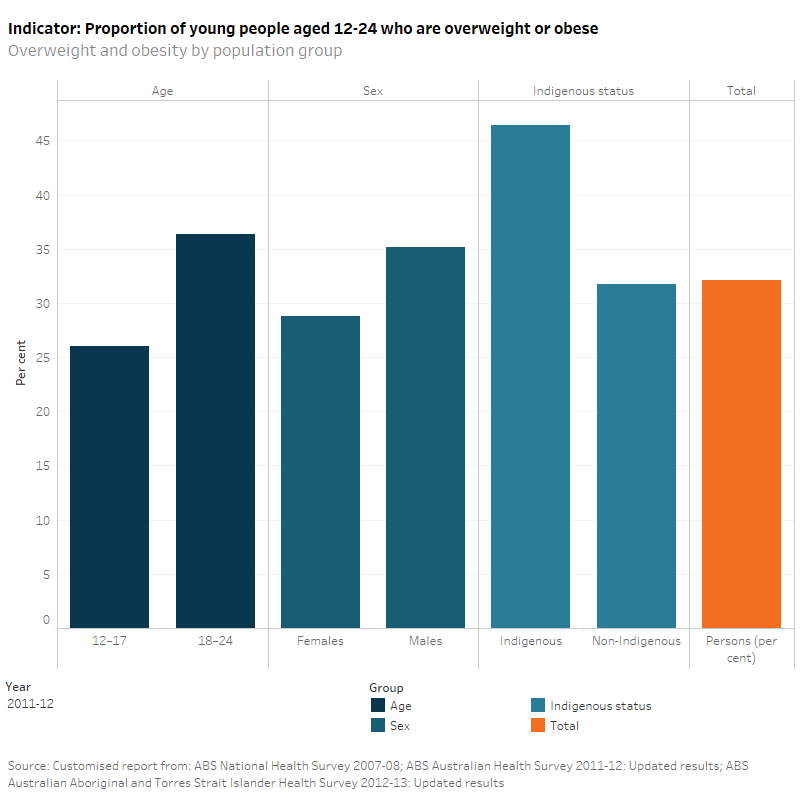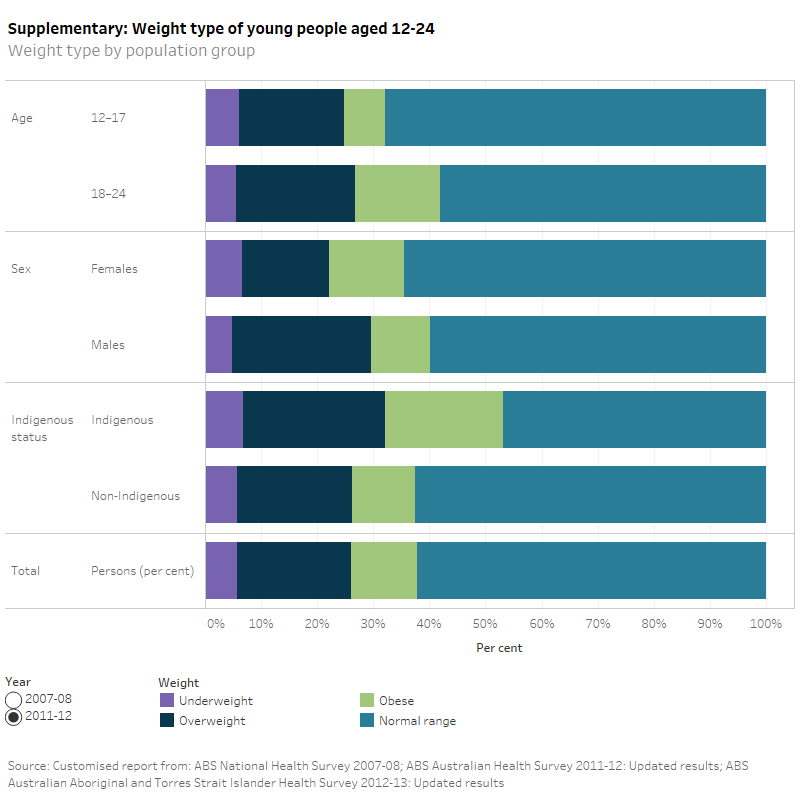Overweight & obesity
Why is reporting overweight and obesity rates important?
Overweight and obesity in young people is a risk factor for many serious health conditions in the short and long term (NHMRC 2013).
Overweight and obese young people are at increased risk of diabetes, stroke, coronary heart disease, hypertension and cancer in later life (Reilly & Kelly 2011). They are also at higher risk of adverse psychosocial outcomes, resulting from teasing, bulling, poor body image and depression (Latzer & Stein 2013). Many obese young people also grow to become obese adults (AIHW 2011).
Do rates vary across population groups?
In 2011–12, around one third (32%) of young people aged 12–24 had a Body Mass Index (BMI) above the cut-off points for ‘overweight’ and ‘obese’ for their age (see Notes for more details). A significantly higher proportion of young people aged 18–24 were overweight or obese (36%) compared with 12–17 year olds (26%).
A greater proportion of males aged 12–24 were either overweight or obese compared with females aged 12–24 (35% and 29% respectively). However, in relation to obesity only, the rate was higher among young females (13%) than among young males (11%).
The largest disparity between populations groups in relation to being overweight or obese was between Indigenous and non-Indigenous young people. The proportion of Indigenous young people who were overweight or obese was almost 1.5 times as high as the rate for non-Indigenous young people (46% compared to 32%).
Has there been a change between 2007–08 and 2011–12?
The ABS Australian Health Survey 2011–12 showed that the only overweight/obese category which increased between 2007–08 and 2011–12 was for those aged 18–24 who were classified as obese (increased from 13% to 15%), however this increase was not statistically significant. In the 4 years since the previous survey there were no significant differences in the proportion of overweight or obese young people aged 12–24 between all of the population groups examined. Research suggests that the obesity rates among children and adolescents may have stabilised between 1996 and 2008 (Olds et al. 2011). However, the prevalence of overweight and obesity among young people remains high, and is therefore a cause for concern (AIHW 2014).


This report is based on survey data; relative standard errors and 95% confidence intervals are provided in the Source data tables: NYIF indicators. Significance testing was undertaken on values cited in the text; unless otherwise stated, differences were found to be statistically significant.
Overweight and obesity can be indirectly measured at the population level using body mass index (BMI). BMI is a measure of the ratio of weight in kilograms divided by height in metres squared (kg/m2). BMI changes substantially with age and can differ for boys and girls. Young people are considered to be overweight or obese if their BMI scores exceed international cut-off points for their specific age and sex for 12–17 year olds (see Cole et al. 2000 for details) or if their BMI ≥25 (or for obese ≥30) for 18–24 year olds (WHO 1998). Overweight and obesity estimates presented here have been obtained by taking into account the differences in BMI scores for 12–17 and 18–24 year olds.
Customised report from: ABS National Health Survey 2007–08; ABS Australian Health Survey 2011–12: Updated results; ABS Australian Aboriginal and Torres Strait Islander Health Survey 2012–13: Updated results
Data quality statement: Not available, please refer to ABS Australian Health Survey 2011–13 for further information.
AIHW (Australian Institute of Health and Welfare) 2011. Key indicators of progress for chronic disease and associated determinants: data report. Cat. no. PHE 142. Canberra: AIHW.
AIHW 2014. Australia’s health 2014. Australia’s health series no. 14. Cat. no. AUS 178. Canberra: AIHW.
Cole TJ, Bellizzi MC, Flegal KM & Dietz WH 2000. Establishing a standard definition for child overweight and obesity worldwide: international survey. British Medical Journal 320(7244):1240–5. See Table 4.
Latzer Y & Stein D 2013. A review of the psychological and familial perspectives of childhood obesity. Journal of Eating Disorders 1:7.
National Health and Medical Research Council (NHMRC) 2013. Clinical practice guidelines for the management of overweight and obesity in adults, adolescents and children in Australia. Melbourne: NHMRC.
Olds T, Maher C, Zumin S, Péneau S, Lioret S, Castetbon K et al. 2011. Evidence that the prevalence of childhood overweight is plateauing: data from nine countries. International Journal of Pediatric Obesity 6:342–60.
Reilly JJ & Kelly J 2011. Long-term impact of overweight and obesity in childhood and adolescence on morbidity and premature mortality in adulthood: systematic review. International Journal of Obesity 35:891–898.
WHO (World Health Organization) 1998. Obesity: preventing and managing the global epidemic. Report of a WHO consultation, Geneva, 3–5 Jun 1997. Geneva: WHO.


